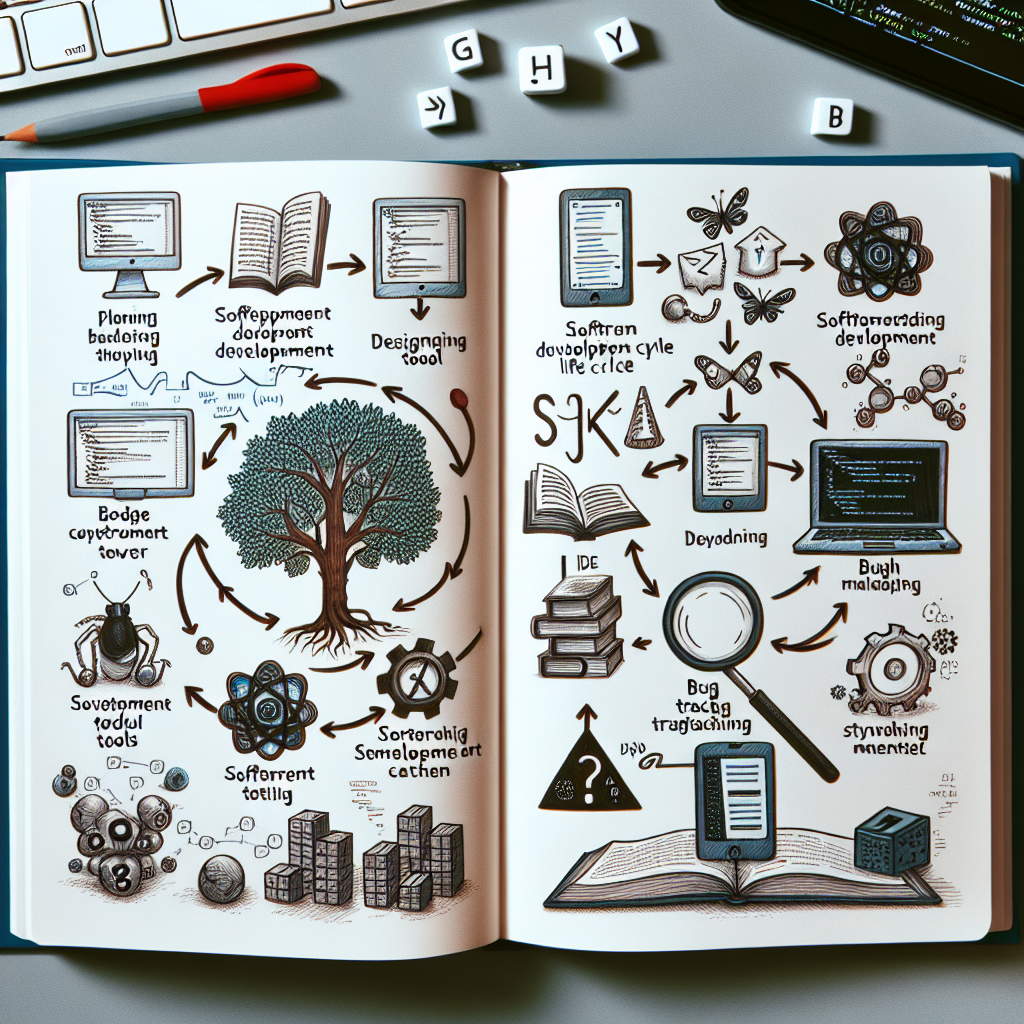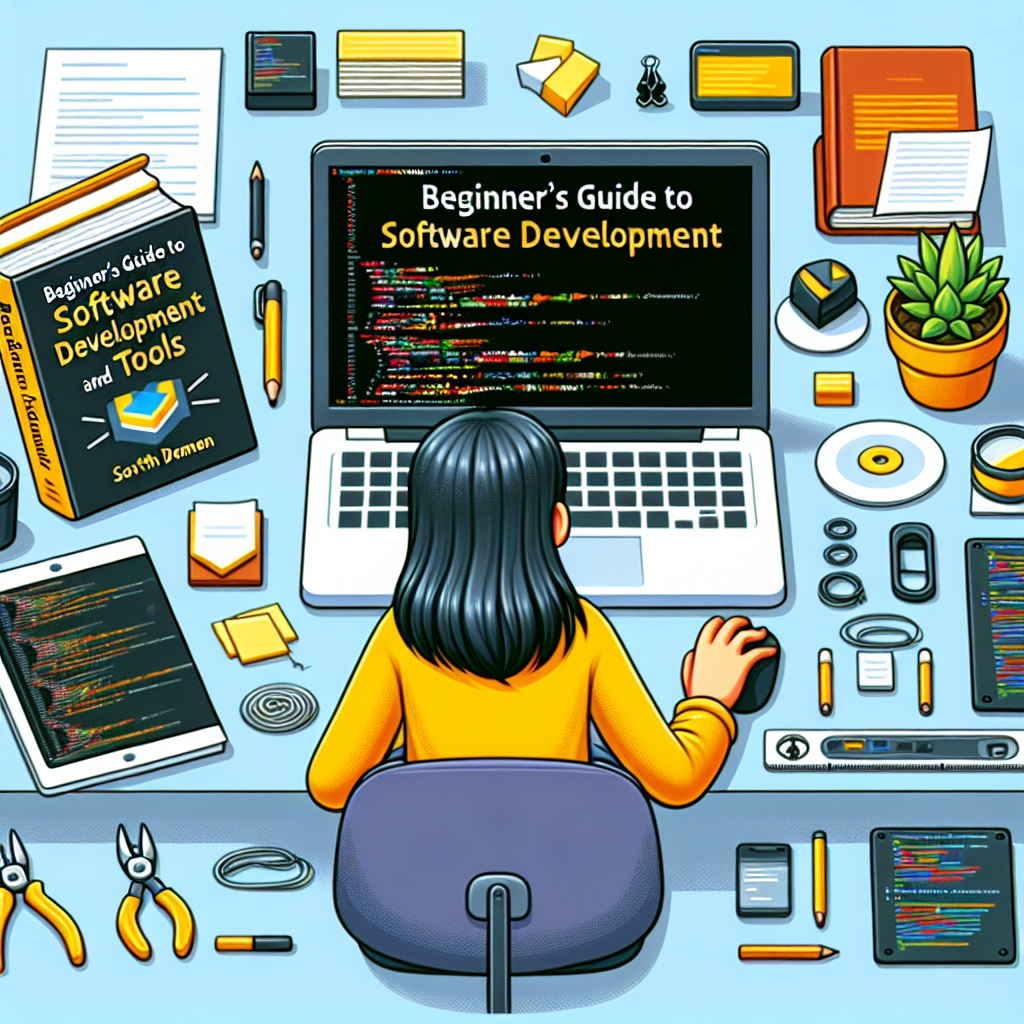-
Table of Contents
- Understanding Programming Languages: A Newbie’s Perspective
- Essential Tools for New Developers: From IDEs to Version Control
- Navigating the Software Development Lifecycle: A Starter’s Handbook
- Introduction to Debugging: Tips and Tricks for New Coders
- Building Your First Project: A Step-by-Step Guide for Novices
- Conclusion
Understanding Programming Languages: A Newbie’s Perspective
Embarking on the journey of software development can be both exhilarating and daunting, especially for those who are just beginning to explore this vast and intricate field. The world of programming languages, with its myriad of options and complexities, often feels like a labyrinth to newcomers. However, understanding these languages is akin to unlocking a new dimension of creativity and problem-solving. As you stand at the threshold of this new world, it is essential to approach it with both curiosity and patience, for the path to mastery is paved with perseverance and continuous learning.
Programming languages are the fundamental building blocks of software development, each with its unique syntax, semantics, and use cases. For a beginner, the first step is to choose a language that aligns with their goals and interests. Python, for instance, is often recommended for its simplicity and readability, making it an ideal starting point for those who wish to grasp the basics without being overwhelmed by complex syntax. Its versatility across various domains, from web development to data science, offers a broad spectrum of opportunities for exploration.
As you delve deeper into the world of programming, it becomes apparent that each language has its own personality and strengths. JavaScript, with its dynamic nature, is indispensable for web development, breathing life into static pages and enabling interactive user experiences. Meanwhile, Java, with its robust architecture, is favored for building large-scale enterprise applications. Understanding these nuances not only broadens your technical skills but also enriches your perspective on how different tools can be leveraged to solve diverse problems.
Transitioning from learning the syntax to applying it in real-world scenarios is a significant milestone in a programmer’s journey. This is where the emotional aspect of software development truly comes into play. The satisfaction of seeing your code come to life, solving a problem, or creating something new is unparalleled. However, this journey is not without its challenges. Debugging errors, optimizing performance, and ensuring code quality can be frustrating, yet these obstacles are integral to the learning process. Embracing these challenges with resilience and a growth mindset transforms them into valuable learning experiences.
Moreover, the software development community is a vibrant ecosystem that thrives on collaboration and knowledge sharing. Engaging with this community, whether through online forums, coding bootcamps, or local meetups, provides invaluable support and inspiration. The camaraderie among developers fosters an environment where questions are welcomed, and solutions are collaboratively sought. This sense of belonging can be a powerful motivator, especially during moments of self-doubt or when the learning curve feels steep.
In addition to mastering programming languages, familiarizing oneself with development tools is crucial. Integrated Development Environments (IDEs) like Visual Studio Code or PyCharm streamline the coding process, offering features such as syntax highlighting, code completion, and debugging tools. Version control systems like Git are indispensable for managing code changes and collaborating with others. These tools not only enhance productivity but also instill best practices that are essential for professional growth.
In conclusion, understanding programming languages from a beginner’s perspective is a journey of discovery, filled with both challenges and triumphs. It requires a blend of technical acumen, emotional resilience, and a willingness to engage with a community of like-minded individuals. As you navigate this path, remember that every line of code you write is a step towards unlocking your potential as a software developer. Embrace the journey with an open heart and mind, for the possibilities are as boundless as your imagination.
Essential Tools for New Developers: From IDEs to Version Control
Embarking on the journey of software development is akin to setting sail on an uncharted sea, filled with both exhilarating possibilities and daunting challenges. For new developers, the landscape of essential tools can seem overwhelming, yet these tools are the very compass and map that will guide them through the intricate world of coding. At the heart of this journey lies the Integrated Development Environment, or IDE, a sanctuary where ideas transform into tangible code. IDEs such as Visual Studio Code, IntelliJ IDEA, and Eclipse offer a nurturing environment, providing features like syntax highlighting, code completion, and debugging tools. These features not only enhance productivity but also instill a sense of confidence in new developers, allowing them to focus on creativity rather than getting lost in the labyrinth of syntax errors.
Transitioning from the comfort of an IDE, the next essential tool in a developer’s arsenal is version control. Imagine crafting a masterpiece, only to lose it in a moment of oversight. Version control systems like Git serve as a safety net, preserving the history of a project and allowing developers to experiment fearlessly. With platforms like GitHub and GitLab, collaboration becomes seamless, transforming solitary coding into a communal experience. These platforms foster a sense of belonging, as developers from around the globe contribute to open-source projects, sharing knowledge and learning from one another. This collaborative spirit is the heartbeat of the software development community, a reminder that even in the solitary act of coding, one is never truly alone.
As new developers navigate this vast ocean, they will inevitably encounter the need for package managers, tools that simplify the process of managing libraries and dependencies. Tools like npm for JavaScript and pip for Python act as trusted allies, ensuring that projects remain organized and up-to-date. These package managers alleviate the burden of manual installations, allowing developers to focus on innovation rather than logistics. The relief they provide is palpable, as they transform what could be a tedious task into a streamlined process, empowering developers to build more complex and robust applications.
In the realm of software development, testing tools are the unsung heroes, ensuring that code not only functions but excels. Testing frameworks like JUnit for Java and PyTest for Python offer a structured approach to verifying code functionality, instilling a sense of pride and accomplishment in developers as they witness their creations withstand rigorous scrutiny. The emotional satisfaction derived from a successful test run is unparalleled, a testament to the developer’s dedication and skill.
Finally, as new developers hone their craft, they will discover the importance of continuous integration and deployment tools. Platforms like Jenkins and Travis CI automate the process of integrating code changes, ensuring that projects remain stable and reliable. These tools embody the spirit of progress, allowing developers to iterate rapidly and deliver high-quality software with confidence.
In conclusion, the journey of a new developer is one of discovery and growth, guided by a suite of essential tools that transform challenges into opportunities. From the nurturing environment of an IDE to the collaborative spirit of version control, each tool plays a vital role in shaping a developer’s path. As they navigate this ever-evolving landscape, new developers will find not only technical proficiency but also a profound sense of belonging within the vibrant community of software development.
Navigating the Software Development Lifecycle: A Starter’s Handbook

Embarking on the journey of software development can be both exhilarating and daunting for beginners. The software development lifecycle (SDLC) serves as a roadmap, guiding developers from the initial idea to the final product. Understanding this process is crucial for anyone aspiring to create impactful software solutions. As you delve into this world, it is essential to grasp the various stages of the SDLC, each of which plays a pivotal role in shaping the final outcome.
The journey begins with the planning phase, where ideas are transformed into tangible goals. This stage is marked by a sense of excitement and possibility, as developers brainstorm and outline the project’s objectives. It is here that the foundation is laid, setting the stage for everything that follows. As you navigate this phase, it is important to remain open to new ideas and perspectives, as they can lead to innovative solutions that might not have been initially considered.
Once the planning phase is complete, the focus shifts to the analysis stage. This is where the emotional intensity of the project begins to build, as developers dive deep into understanding the requirements and constraints. It is a time of introspection and critical thinking, as every detail is scrutinized to ensure that the project aligns with the intended goals. This stage demands patience and perseverance, as it often involves revisiting and refining initial ideas to better suit the project’s needs.
With a clear understanding of the requirements, the design phase emerges as a beacon of creativity and innovation. This stage is where developers can truly express their vision, crafting the architecture and interface that will bring the project to life. The emotional investment in this phase is profound, as developers pour their passion and expertise into creating a blueprint that will guide the subsequent stages. It is a time of collaboration and inspiration, as team members work together to ensure that the design is both functional and aesthetically pleasing.
As the design takes shape, the development phase begins, marking a period of intense focus and dedication. This is where the abstract becomes tangible, as lines of code are written and the software starts to take form. The emotional journey reaches a crescendo here, as developers experience the satisfaction of seeing their hard work materialize. However, this phase also presents challenges, as unforeseen issues may arise, requiring adaptability and problem-solving skills to overcome.
Following development, the testing phase serves as a critical checkpoint, ensuring that the software functions as intended. This stage is characterized by a mix of anticipation and anxiety, as developers eagerly await the results of their efforts. Rigorous testing is essential to identify and rectify any bugs or errors, ensuring that the final product is reliable and robust. The emotional rollercoaster of this phase is tempered by the knowledge that each test brings the project one step closer to completion.
Finally, the deployment and maintenance stages mark the culmination of the software development lifecycle. The sense of accomplishment and pride is palpable as the software is released into the world, ready to make a difference. However, the journey does not end here, as ongoing maintenance ensures that the software remains relevant and effective. This stage is a testament to the enduring commitment of developers, who continue to nurture and improve their creation long after its initial release.
In conclusion, navigating the software development lifecycle is an emotional and rewarding experience. Each stage presents unique challenges and opportunities, shaping both the software and the developers themselves. By embracing this journey with an open heart and mind, beginners can transform their ideas into impactful solutions that resonate with users and stand the test of time.
Introduction to Debugging: Tips and Tricks for New Coders
Embarking on the journey of software development is akin to setting sail on an uncharted sea, filled with both exhilarating discoveries and daunting challenges. For new coders, one of the most formidable obstacles encountered is debugging. This process, often perceived as a tedious chore, is in fact a crucial skill that transforms mere code into a functional masterpiece. Understanding the art of debugging is essential, as it not only refines your code but also hones your problem-solving abilities, fostering a deeper connection with the logic and creativity inherent in programming.
As you delve into the world of debugging, it is important to approach it with patience and an open mind. The initial encounter with a bug can be frustrating, evoking a sense of helplessness as you stare at lines of code that refuse to cooperate. However, it is in these moments of struggle that growth occurs. Embrace the challenge as an opportunity to learn, for each bug resolved is a step towards mastery. Begin by familiarizing yourself with the tools at your disposal. Integrated Development Environments (IDEs) such as Visual Studio Code, Eclipse, or IntelliJ IDEA offer built-in debugging tools that can simplify the process. These tools allow you to set breakpoints, inspect variables, and step through your code line by line, providing invaluable insights into the inner workings of your program.
Moreover, cultivating a methodical approach to debugging can significantly enhance your efficiency. Start by reproducing the bug consistently, as this will help you understand the conditions under which it occurs. Once you have a clear picture, isolate the problematic section of code. This can be achieved by employing a divide-and-conquer strategy, systematically narrowing down the source of the issue. As you dissect your code, remember to keep detailed notes of your observations and hypotheses. This practice not only aids in tracking your progress but also sharpens your analytical skills.
In addition to technical strategies, developing a mindset of resilience and curiosity is paramount. Debugging is not merely a task to be completed; it is a journey of discovery. Each bug is a puzzle waiting to be solved, a mystery that beckons you to unravel its secrets. Approach each challenge with a sense of wonder, and allow yourself to be captivated by the intricacies of your code. This emotional engagement transforms debugging from a mundane task into a rewarding experience, where each solution brings a sense of accomplishment and joy.
Furthermore, do not hesitate to seek assistance when needed. The software development community is a vast and supportive network, eager to share knowledge and offer guidance. Online forums, coding groups, and mentorship programs provide a wealth of resources for new coders. Engaging with this community not only accelerates your learning but also fosters a sense of belonging, reminding you that you are not alone on this journey.
In conclusion, debugging is an integral part of software development that demands both technical acumen and emotional resilience. By embracing the challenges it presents, utilizing the tools available, and cultivating a mindset of curiosity and perseverance, new coders can transform debugging from a source of frustration into a powerful tool for growth and discovery. As you navigate the complexities of code, remember that each bug resolved is a testament to your progress, a milestone on the path to becoming a skilled and confident developer.
Building Your First Project: A Step-by-Step Guide for Novices
Embarking on the journey of software development can be both exhilarating and daunting for beginners. The prospect of creating something from nothing, of bringing an idea to life through code, is a powerful motivator. However, the path to building your first project is often fraught with challenges and uncertainties. Yet, with the right guidance and tools, this journey can transform from a daunting task into a rewarding experience.
To begin with, it is essential to understand the importance of planning. Before diving into coding, take a moment to conceptualize your project. Ask yourself what problem you aim to solve or what purpose your software will serve. This initial step is crucial, as it lays the foundation for everything that follows. Once you have a clear vision, break down the project into smaller, manageable tasks. This approach not only makes the process less overwhelming but also provides a sense of accomplishment as you complete each task.
As you move forward, selecting the right tools is paramount. The world of software development is rich with options, and choosing the appropriate tools can significantly impact your project’s success. For beginners, integrated development environments (IDEs) like Visual Studio Code or PyCharm offer user-friendly interfaces and a plethora of features that simplify coding. These tools provide syntax highlighting, code completion, and debugging capabilities, which are invaluable for novices.
Moreover, version control systems such as Git are indispensable in modern software development. They allow you to track changes, collaborate with others, and revert to previous states if necessary. Platforms like GitHub or GitLab provide a space to host your code and collaborate with a community of developers, offering both support and inspiration.
As you delve into coding, remember that learning is an iterative process. Mistakes are inevitable, but they are also opportunities for growth. Embrace them as part of your learning journey. Online resources, such as Stack Overflow and various coding forums, are treasure troves of information where you can seek help and learn from others’ experiences. Additionally, tutorials and online courses can provide structured learning paths, guiding you through the complexities of programming languages and frameworks.
Testing is another critical aspect of software development that should not be overlooked. Writing tests for your code ensures that it functions as intended and helps identify bugs early in the development process. Familiarize yourself with testing frameworks relevant to your chosen programming language, as they will become invaluable tools in your development arsenal.
As you near the completion of your project, the deployment phase awaits. This stage involves making your software available for others to use. Depending on the nature of your project, this could mean deploying a web application to a cloud service like AWS or Azure, or packaging a desktop application for distribution. The deployment process can be complex, but it is the final step in bringing your creation to life.
In conclusion, building your first software project is a journey filled with learning, challenges, and triumphs. By planning carefully, choosing the right tools, embracing mistakes, and seeking help when needed, you can navigate this path with confidence. Remember that every expert was once a beginner, and with perseverance and passion, you too can create something remarkable. As you stand on the precipice of this new adventure, take a deep breath and step forward, knowing that the world of software development is yours to explore.
Conclusion
The “Beginner’s Guide to Software Development and Tools” provides a comprehensive introduction to the fundamental concepts and essential tools necessary for aspiring software developers. It covers the basics of programming languages, development environments, version control systems, and debugging techniques. The guide emphasizes the importance of understanding the software development lifecycle, including planning, coding, testing, and deployment. By familiarizing beginners with popular tools such as integrated development environments (IDEs), Git for version control, and collaboration platforms, the guide equips them with the skills needed to effectively participate in software projects. Overall, it serves as a valuable resource for newcomers, laying a solid foundation for further exploration and growth in the field of software development.


